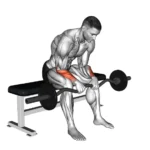Smith Machine Shoulder Press: Exercise Overview
The Smith machine shoulder press is a highly effective variation of the traditional overhead press, designed to target and strengthen the shoulder muscles, particularly the deltoids. By using a Smith machine, the bar follows a fixed vertical path, reducing the need for balance and stabilization compared to a free-weight barbell. This makes it a great option for lifting heavier weights safely, especially without a spotter. As a foundational upper-body movement, the shoulder press builds strength and promotes a balanced, well-proportioned physique. It’s versatile and can be incorporated into shoulder-focused sessions, push workouts, upper-body routines, or full-body training plans.
How to Perform the Smith Machine Shoulder Press
- Place an adjustable bench inside the Smith machine and set the backrest to a 90-degree upright position.
- Position the barbell at approximately eye level and load it with your desired weight.
- Grip the bar with a pronated (palms-forward) grip, hands placed slightly wider than shoulder-width.
- Unrack the bar by rotating your wrists to release the safety hooks—this is your starting position.
- Press the bar overhead by fully extending your elbows and engaging your shoulder muscles.
- Lower the bar back to the starting position with control, stopping when your arms form a 90-degree angle or slightly below, depending on your arm length.
- Repeat for the desired number of repetitions.
Tips for Optimal Performance
- Focus on a slow, controlled descent to maximize muscle engagement and minimize the risk of injury.
- Keep your head aligned with your spine, avoiding excessive forward tilt to maintain proper posture.
- As you press, aim to bring your biceps in line with your ears and exhale to maximize force and control.
- If you feel tension in your neck or upper traps, check for limited thoracic spine mobility or restricted shoulder range of motion, and consider mobility exercises to address this.
- Difficulty fully extending your arms overhead may indicate limited shoulder mobility, often due to poor scapular movement. Incorporate scapular mobility drills to improve performance.
- Maintain a braced core throughout the movement to support your spine and enhance stability.
Sculpting your shoulders with presses? Learn how to train every deltoid in our Ultimate Guide to Muscle Groups.







